|
Related FAQs: Fishes of
Hawai'i, Articles on: The Best
Butterflyfishes of Hawai'i, Triggerfishes of
Hawai'i,
Related Articles: A
Fishwatcher's Guide to the Marine Aquarium Fishes of
Hawai'i, Introduction to
Fishwatcher's Guide Series
Pieces/Sections, Scott's Trip to
Maui/Hawai'i, Holualoa property,
A Fishwatcher's Guide to the
Marine Invertebrates of Hawai'i
Part 1 of 4, To: Part
2, Part 3, Part 4,
|
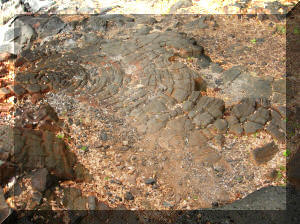
|
|
Bob Fenner
|
Other reasons to visit: Beautiful lava
formations
|
Due to it's geographical placement, the principal islands of
Hawai'i find themselves treated as a distinct sub-faunal region of
the Indo-Pacific. Ocean currents and distances from other shallow water
areas have conspired to produce a large proportion of endemic
near-shore marines. Indeed Hawai'i vies with the Sea of Cortez of
Mexico's eastern Pacific coast, and the Red Sea for percentage of
endemic fish species, with about a quarter found only there.
And what an abundance for Fishwatcher's and aquarists! More than
a hundred fishes (and a few invertebrates) are collected for our
interest from Hawai'i's principal islands. Some you know well,
like the Yellow Tang, Zebrasoma flavescens, others ought to be
more utilized in our interest like the beautiful, hardy and abundant
Milletseed Butterflyfish, Chaetodon miliaris. How many species
of wrasses, moray eels and butterflyfishes can you find here? Some
forty three, thirty eight and twenty four species respectively!
There are many dive and snorkeling spots to explore, where you can
glimpse this vast fauna up close one on one, and a few nice public
aquariums with interpretive displays. Add to that the fact that
America's 50th state has excellent year round weather, air flight
services, and accommodations, and it's hard to find a better place
to visit to investigate the aquatic world.
Here is my account of the species of tropical fishes utilized in the
hobby and trade of aquarium keeping that hail from Hawai'i and
their scored survivability. Also listing some that should be left out,
others that ought to be added and brief notes on their, range, feeding
habits, ecotype, and other pertinent husbandry tidbits. My intent is
obvious. To encourage you to witness the living world firsthand, to
inform "all the players" especially collectors and
"end-user" consumers (hobbyists) of the best livestock
available, and reciprocally to discourage use of inappropriate
species.
Ecotype Statements
I've offered some broad strokes here in describing very
generally where the various fish groups and species are typically
found. Other authors have been much more specific in defining reef
geographies and particular niches, but I'll assure you that
duplicating biotopes is not essential. Indeed, almost all hobbyist
arrangements are a mish-mash of mixed species that would never meet in
the wild, and most get along just fine.
On the other hand, I cannot encourage you enough to go beyond the
simple statements offered here in investigating and doing your best to
mimic a physical and biological slice of the ocean (or any part of the
"real" world you'd like to recreate in miniature). The
printed works listed here, Internet, and actual travel to the area are
the best means of gaining knowledge of what makes up a given habitat,
living and physical.
Captive Suitability Scoring:
After long thought, investigation of others declared opinions, and
handling tens of thousands of these species I've come to a set of
"scores" for each on its likelihood of surviving the rigors
of aquarium care. Yes, to some degree this information is necessarily
historical (what has happened, may not be the general trend to come),
and is subject to "improvement" on the keepers side as a
consequence of providing larger, more stable quarters (like public
aquariums), and more diligent husbandry. But, by and large a relative
score of one (1) indicates the "highest and best"
survivability under captive conditions; let's say most of the
specimens of this species collected surviving more than three months. A
score of two (2) is indicative of mortality of more than fifty percent
between one and three months. Lastly, and sufficient for our purposes,
a three (3) is the worst score, with more than 50% of the species
perishing before a months time of capture. I entreat you to leave the
latter group to the sea, or at least to study about their care ardently
and provide the best possible circumstances for these animals.
Non-Fish Underwater Life of Hawai'i
Algae: Macro Brown, Red, Green... (ref.:
ReefWatcher's Field Guide to Alien and Native
Hawaiian Marine Algae
| Caulerpa
racemosa, Green Grape Algae. At right in
Hawai'i. |
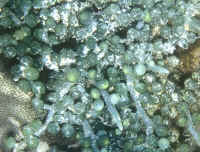
|
| Galaxaura sp. (maybe G. marginata,
see: Galaxaura
species in Hawaii) At right in Hawai'i and below, a
bleached-out colony in the Red Sea, and a small piece off Cozumel.
Distinct dichotomously branching species of pink to red
color. |

|
| Halimeda sp., Money or Cactus Algae for its
circular, coin-like segments. One of twenty five or so marine
species of this coralline (yes, though not a Red or encrusting)
Green Algae can be found in sparse patches (H. incressata
occasionally occurs as a dominant species). Here on the Big Island.
In places a considerable contributor to sand make-up... look close
at the white small chunks on the beach. |
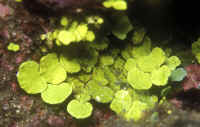
|
| Padina sp., Scroll Algae,
a calcium carbonate encrusting Brown Algae in the wild or marine
aquariums. This is Padina jamaicensis in Belize. |
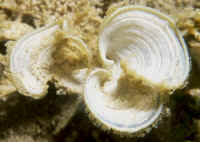
|
| Peyssonnelia sp. An encrusting Red. Class
Rhodophyceae, Subclass Florideophycidae, Order Gigartinales, Family
Peyssonneliaceae. Below, in an aquarium, Cozumel and the Red
Sea. |
| Turbinaria ornata. Kona, Hawai'i
pix. |
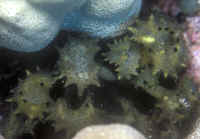
|
| Ulva, Sea Lettuce, this
and related Enteromorpha are great fish foods. |
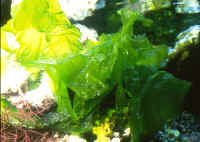
|
Sponges:
| Leiodermatium sp. Wavy Cave Sponge. Hard to
the touch and distinctive in shape. Found in caves, within
crevices. May be endemic to Hawai'i. Kona pix. |
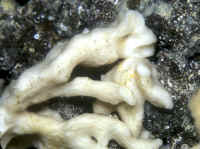
|
| Phorbas sp. Red Phorbas Sponge. Densely
covered with pores and excurrent openings. Encrusts dead and live
corals. Kona pix. |
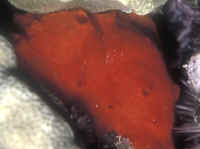
|
| Spirastrella (Sphenciospongia)
vagabunda Ridley 1884, the Vagabond Boring Sponge. Bores its
way into carbonate places (rock, corals...) by acidic secretion. An
important group of organisms for "recycling" limestone.
Hawai'i photos. |
 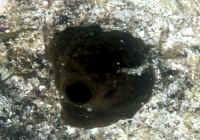
|
| Strongylphora sp., Amorphous Cave Sponge.
Creamy though hard to the touch, fuzzy finger-like appearance.
Found deep in caves and lava tubes (Pukas), covering walls at
times. Kona pix. |
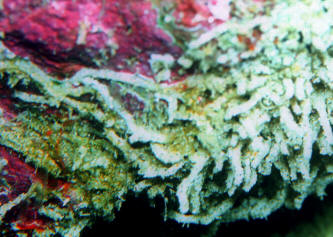
|
| Stylinos sp., Orange Stylinos Sponge. Rough
cellulose appearance. Soft material that is easily torn, but
don't touch. This sponge will stain and irritate skin. Only a
few inches across. Kona pix. |
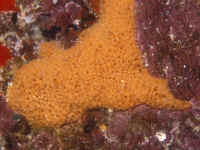
|
| Suberites sp., Blue Suberites Sponge.
Intensely blue, as thin sheets. Occurs in high surge areas.
Colonies in crevices are a few inches across. Kona pix. |
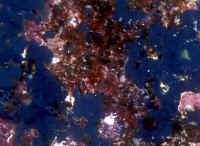
|
To: Part 2, Part 3, Part
4,

